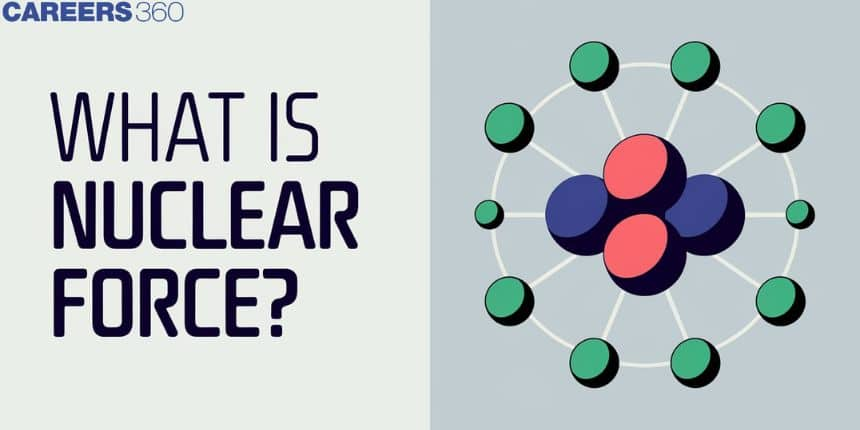What is Nuclear Force - Definition, Example, Properties, FAQs
The nuclear force is also known as a strong force that keeps protons and neutrons (nucleons) bound at the atomic nucleus. Despite the natural repulsion between positively charged protons, this force ensures the stability of the nucleus. It works at very close range and it is one of the forces of nature that are most powerful. Nuclear force is useful in the vital processes of nuclear fusion, and nuclear fission and also in the creation of elements in stars. Let's learn the concept of Nuclear Force in detail with the help of the article below.
JEE Main/NEET 2027: Physics Important Formulas for Class 10
NEET 2025: Mock Test Series | Syllabus | High Scoring Topics | PYQs
JEE Main: Study Materials | High Scoring Topics | Preparation Guide
JEE Main: Syllabus | Sample Papers | Mock Tests | PYQs
- What is Nuclear force?
- Types of Nuclear Forces
- Characteristics of Nuclear Force
- Examples of Nuclear Force

What is Nuclear force?
"The nuclear force is the force that ties up the protons and neutrons in a nucleus cooperatively. It is the strong attractive force that binds the nucleons together."
Nuclear force, also known as the strong force, is a fundamental interaction that binds protons and neutrons together within an atomic nucleus. Despite protons repelling each other due to their positive charge, nuclear force overcomes this repulsion to keep the nucleus stable. This force operates at extremely short ranges and is one of the strongest forces in nature.

Types of Nuclear Forces
The major types of nuclear forces can be categorized as follows:
- Strong Nuclear Force
- Weak Nuclear Force
Strong Nuclear Force: Strong force is resonsible for binding protons and neutrons together in the atomic nucleus.
- It ensures the stability of atomic nuclei.
- Range- 1-2 fm
- Ability to overcome electromagnetic repulsion between protons.
Weak Nuclear Force: Processes like beta decay, where a neutron transforms into a proton, electron, and antineutrino take place because of this force.
- It governs nuclear reactions and radioactive decay.
- Acts over an extremely short range (

Also read -
- NCERT Exemplar Solutions for All Subjects
- NCERT Notes For All Subjects
- NCERT Solutions for All Subjects
Characteristics of Nuclear Force
- Charge Independence: It’s a charge-independent force and its magnitude is the same for p-p, p-n, or n-n.
- Short-Range Force: They very short-range forces and are effective only up to a distance of 1-2 fm (fermometers).
- Strongest Force in Nature: It is the strongest force in nature and its magnitude is about 100 times stronger than interaction.
- Saturation: Nuclear force may be a saturation force as a given nucleon can interact only with its immediate neighbour’s and not all the nucleons present in the nucleus.
- Non-Central Force: It has a non-central component called the tensor force, which depends on the relative orientation of the spins of the interacting nucleons.
- Spin Dependency: It’s a spin-dependent force. Nucleons having parallel spin are more strongly sure of one another than nucleons having an antiparallel spin
|
Related Topics |
Examples of Nuclear Force
- It binds protons and neutrons (nucleons) together in the atomic nucleus despite the strong electromagnetic repulsion between protons.
- Responsible for Deuteron Formation (nucleus of deuterium,
- In nuclear fusion as in the sun hydrogen nuclei (protons) overcome their electromagnetic repulsion to form helium nuclei via nuclear force.
- In neutron stars, densities are so high that neutrons are only a few femtometers apart from each other the nuclear force of attraction keeps them from being gravitationally crushed.
- Nuclear fission (atomic bomb) and nuclear fusion (hydrogen bomb) both operate on the energy produced by control of nuclear forces.
Frequently Asked Questions (FAQs)
The unification of forces is that the concept it's possible to weave all of nature’s force into one comprehensive force. Scientists have made great strides toward understanding how the forces are often combined.
Newton realized that an equivalent gravity that describes an apple falling from the tree also describes the moon’s orbit round the Earth. Later within the 19th century, James Clerk Maxwell demonstrated that electric and magnetism to be a facet of one electromagnetic force. Finally, within the 20th century, Weinberg, Abdus Salam, and Sheldon Lee Glashow discovered that at high energies, the electromagnetic force and therefore the weak interaction merge into one electroweak force.
The four fundamental forces, also referred to as the Universal forces are electromagnetic force, strong nuclear force, weak nuclear force, and gravitation. Among these forces, gravitation is that the weakest and therefore the strong nuclear force is that the strongest. The strong nuclear force acts over a little distance while gravity acts over an extended distance.
The strongest force in nature is that the strong nuclear force. it's also referred to as strong nuclear interaction and is that the strongest compared to the opposite forces that exist in nature. The forces are:
(a) Gravity
(b) The weak interaction (Weak nuclear interaction)
(c) Electromagnetism
(d) The strong interaction (Strong nuclear interaction)
Following are the factors affecting the worth of acceleration thanks to gravity:
Height from the earth’s surface
Latitude of the plane
Depth
Ampere law is additionally referred to as Ampere circuital law which states that the closed integral of the magnetic flux intensity is that the same because the current enclosed by it.
Also Read
28 Nov'24 05:49 PM
28 Nov'24 10:14 AM
28 Nov'24 10:06 AM
08 Oct'24 03:32 PM
24 Sep'24 05:17 PM
29 Aug'24 09:52 AM

